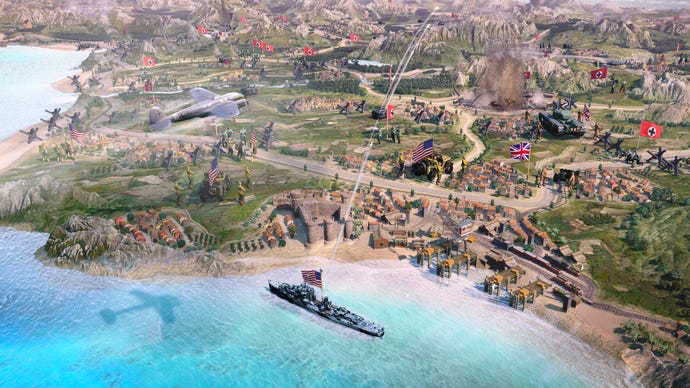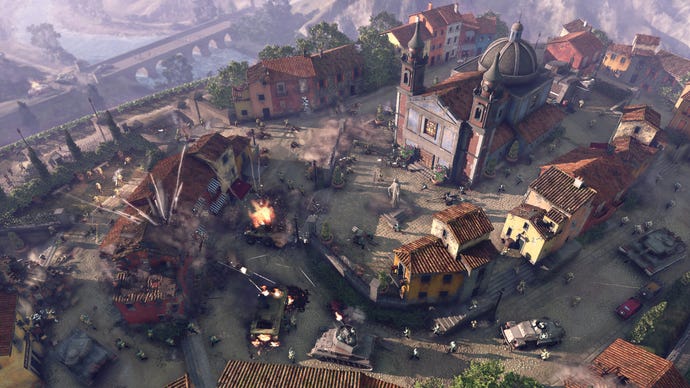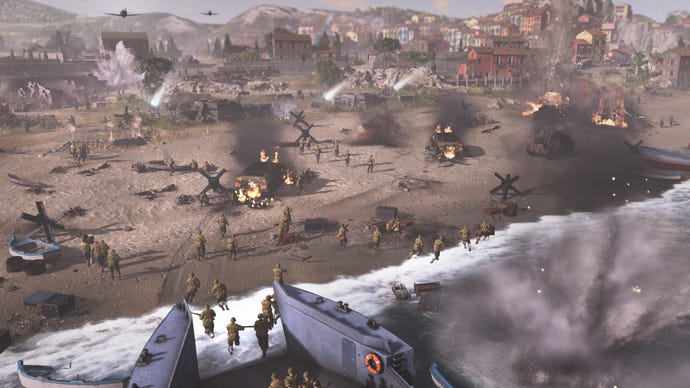Hands on with Company Of Heroes 3 - aka Total War: WW2
We put a war in your war, so you can war while you war!
The Total War series are the Kinder Eggs of strategy gaming: a layer of delicious, map-based strategy, with a dramatic RTS toy hidden inside. It's a tasty formula, and I've often wondered why more games over the years haven't adopted it. I'm not alone in this: David Littman, executive producer at Relic Entertainment, always wondered the same thing. But then along came Sega, gulping down strategy studios like a big mad whale, and Relic ended up in its belly - right next to Total War devs Creative Assembly. So he asked them about it.
“Turns out,” says Littman, “it’s because it’s really hard to do”. So there you go. But Littman was not deterred. Working away in the leviathan's guts, with the famous motto of the SAS in mind - “You’ve got to at least have a go, even if it's really hard” - Relic learned from their fellow strategy Jonahs at CA, and set about applying the knowledge to their landmark WW2 strategy franchise, Company Of Heroes. Now, the Sega whale, she is a-rumblin'. Sometime next year in late 2022, she will belch up Company Of Heroes 3, and it will have a brand new, Total War-style campaign map. I've ventured down the whale's gullet to have a go, and I think it looks promising.
Now, just quickly: if I sound cagey there, it's only for the sake of fairness. Because while the build I played showed off an impressive range of features, especially for a pre-alpha, there were definitely some rough edges. It’s one of those situations where to emphasise the rough bits would be unfair on Relic, but to make glowing assumptions about work yet to be done would be unfair to you. Honestly, it'd be best to see it for yourself - and as it happens you can do just that, as Relic have made a version of the build available for a couple of weeks. You can find out more about how to sign up over on their website.
Anyway, let's talk about the game. Company Of Heroes 3 will whisk us away to the Mediterranean, for a jaunt through the only WW2 theatre (besides the Pacific) not yet tackled by the series. It’s hard to tell how broadly Relic are defining the theatre, mind. Because while the preview event was focused entirely on the 1943 allied invasion of Italy, North Africa will also be involved, and potentially other locations. Currently, it's a mystery. So, for now: Italy.

The campaign map - props to art director Tristan Brett - is beautiful. And while I don’t know to what degree its inner workings have been grown from Total War stem cells, or whether it's more of an "inspired by" job, it's similar enough to be played on instinct by Total War veterans, without feeling cloned. As the War King, you command companies (represented by big old tanks) around the map, fighting some enemies entirely within the strategic layer, and jumping into more familar CoH RTS battles when it comes to decisive location battles.
Also under your command on the campaign map are specialist detachments, which you can position in support of your main forces, bombing runs which you can launch from friendly bases, partisans you can send on various guerilla operations, and - my favourite - big, burly warships which you can move around the coast to rain shells on enemy positions.
When an RTS battle opens up, your company (of heroes) will be transformed into a starting base, and a set of units. What they are, and what you can go on to build, will depend on what units your company comprised on the campaign map.
Pounding a German airfield with naval artillery saw the battle map transformed into a mess of rubble and craters, providing welcome cover when I went on the offensive.
Relic’s aim is to have as much interplay as possible between what takes place on the campaign map, and in the missions themselves. This is a work in progress, apparently, but there’s already enough in place to give me a definite sting of satisfaction. Having a medical detachment within range of a battlefield, for example, gave me the ability to summon in some medical trucks as reinforcements, while pounding a German airfield with the aforementioned burly warships saw the battle map transformed into a mess of rubble and craters, providing welcome cover when I went on the offensive.
You can, it seems, approach the campaign in any way you like. Starting in the autumn of 1943, it’s up to you where to land, what forces you land with, and what you do with them after that. Even individual battles have multiple approaches, depending on whether you opt for the American plan of attack, the British plan, or some form of tense compromise. Each offers different conditions in terms of starting forces, reinforcements, and - I believe - objectives. Factoring in the various situations you can set up with supporting forces, artillery and the like, and you’ve got a huge amount of variety in the way missions can play out.

Indeed, rather than use my time with the game to progress as far as possible, I wanted to look at replayability, and so I kept re-running the first mission after the starting save - an assault on the German-held Pomigliano airfield - with as many different parameters as I could set up. With just one turn in which to set up my variables, I managed to play the battle in several distinctly different ways, which pleased me fulle welle.
The campaign won’t be a complete sandbox, of course. In a manner not dissimilar to the Total Warhammer games, there’s a central chain of set-piece missions to be accomplished in sequence. But you can approach these at your own pace, with as much extracurricular bruting as you care to dish out in order to strengthen your position between these key fights.
While we’re talking about variety, it’s worth relaying Relic’s excitement about finding as many interesting toys as possible to throw into the fray for Company Of Heroes 3. Responding to player criticism of CoH2, it seems they’re trying to align this game much more closely with the original Company Of Heroes, and part of that process is a greater focus on the importance of infantry. But even with that in mind, the number of armoured vehicles in the game’s unit list is - according to lead campaign designer Andrew Deneault - around three times greater than it was in CoH2.
In just the small part of the game played, I got to take a dizzying array of armour for a spin. I have a huge soft spot for tanks, being as they are the brutes of the machine world, and CoH3 made them a joy to field. The plucky little Stuart Light Tank, with its 37mm gun blasting away in a satisfyingly rapid puff-thud-puff-thud, was perfect for flanking German defensive positions in nimble packs, while a stolen German anti-aircraft tank turned out to be an absolute riot when I turned its guns on a panicking nest of Wehrmacht.

International variety, too, is a big objective for Relic in Company Of Heroes 3, and Italian partisan resistance fighters in particular will (surprise) be a big feature in the Italian campaign. Currently, they’re largely a resource to be used on the strategic map, with favours you can call them in for during RTS segments - although the release build will apparently include a variety of Italian units for both Allied and Axis forces. Beyond that, I made devastating use of a detachment of Indian artillery, and even got to field some Gurkhas. Since CoH3 doesn’t feature melee combat, I was initially disappointed that I wouldn’t see their legendary Kukri blades in action. Nevertheless, as it turned out, they had an option to... throw them? That was an odd one, but a welcome creative workaround nonetheless.
One of the other aspects of the game Relic were keen to emphasise during my hands on with the game was its commitment to close-focus, “boots on the ground” atmosphere. And indeed, there’s a lot of character to the forces under your command. The voice acting was great, with unit acknowledgement barks being far more colourful than the dreaded monotony of “Yes sir!”, “Acknowledged!”, and “Moving out!”. The British squaddies in particular had a brilliantly accurate vernacular, in that they swore constantly. They kept calling each other wankers. They called buildings wankers. I think they even called me a wanker. All of this did exactly what it was meant to, and half-tricked me into thinking of them as people, rather than units in a strategy game.
The British squaddies in particular had a brilliantly accurate vernacular, in that they swore loads.
There’s potential for some good narrative kicks to be had from the campaign, too. Throughout the turns I played, I was receiving comms from the British general in charge of the landings, as well as his American counterpart, and there was a clear sense of mutual animosity and one-upmanship between them. Italy represented the first Allied joint operation of its kind, and since such tensions were very real and well-documented, it's a great theme for the game to explore.

The “boots on the ground” approach notwithstanding, I sometimes found the focus a bit too close, in the very literal sense that the camera seemed too zoomed in, all of the time. I remember the wild frustration I felt with Relic’s original Dawn Of War, in which the camera glared down on an approximately postage-stamp-sized square of battlefield, and where I knackered my wrists with the constant, frantic scrolling necessary for getting any sense of the wider battle. Those memories returned to me a little with Company Of Heroes 3, with the perpetual sense of wanting to zoom out just a little further, or rotate the camera, so as to get a better intuition of the tactical landscape.
Plainly put, it's really hard to think of your overall deployment and get a sense of the flow of battle when you’re forever staring at an area barely larger than the size of the average London rental accommodation. It makes it hard to coordinate action in multiple hotspots across the map, too, even with hotkeys. I asked Relic if I could have a little less zoom in the final build, as a treat, and they told me: “We will be listening to players and make adjustments based on that”. Fair enough, I suppose. It’s not like the field of view issue is a dealbreaker for me - I'd just prefer to see more.
This brings me on to the other big innovation in Company Of Heroes 3, which in fairness helped me out a lot when trying to fight and win across multiple points on the map - tactical pause. While it’s obviously not going to be available in PvP multiplayer, being for campaign use only, the ability to freeze time and issue every unit with fresh orders was, once I’d started using it frequently, game-changing.

Indeed, it soon became obvious to me that I could play the campaign in two very different ways - without tactical pause, making for a more traditional RTS experience, with frantic, edge-of-chaos engagements being the norm, or with tactical pause, leading to much leaner, micromanaged battles against tougher AI. Honestly, I’m not sure yet which direction I’m more inclined towards. But it's pleasant to have the choice. And I suppose that sums up my feelings towards Company Of Heroes as a whole, given what I’ve seen so far. Simply put, there's an awful lot of freedom offered to the player, and the variability resulting from it serves as an invitation to play over and over again, trying out alternative methods.
"I think Relic realises that some people just want to play out their own wars, at their own pace."
Low replayability has been the downside to many an RTS classic, and so it's bloody welcome here. I think that'll be a widely-held opinion, too. Although Company Of Heroes has always been big for multiplayer I think Relic realises that not everyone wants to compete against other humans - they just want to play out their own wars, at their own pace, feeling satisfied by tanks. The Total War games are pretty much the only RTS games I go back to time and time again for single-player campaigns, thanks to the capacity for each run to unfold in new and exciting ways. If Company Of Heroes 3 can now pull off the same trick, only with more tanks, I’ll be a happy man indeed.


